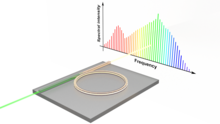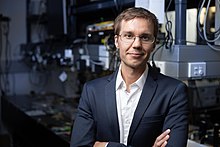Miro Erkintalo
Miro Erkintalo is a Finnish physicist specialising in nonlinear optics and laser physics, based at the University of Auckland.
Miro Erkintalo | |
|---|---|
.jpg) | |
| Nationality | Finnish |
| Alma mater | Tampere University of Technology (BSc, MSc, DSc) |
| Scientific career | |
| Fields | Nonlinear optics Laser physics |
| Institutions | |
Education
Erkintalo was born and grew up in Pori, Finland, with an interest in science and maths. He attended the Tampere University of Technology intending to get his MSc and become a teacher or technologist, but after interning in a research lab decided to become a physicist.[1] He completed three degrees in succession: a BSc (March 2009), an MSc (November 2009) and Doctor of Science in Physics (January 2012).[2]
After his PhD, Erkintalo came to New Zealand in 2012 to take up a postdoctoral fellowship at the University of Auckland, at the suggestion of his mentor John Dudley.[1][3] He had intended to just stay for two years, but enjoyed New Zealand so much he became a permanent resident.[1] He became a Lecturer in the Department of Physics in 2014 and Senior Lecturer in February 2017.[2] He is a principal investigator at the Dodd-Walls Centre for Photonic and Quantum Technologies.[4]
Areas of research

Erkintalo studies laser light and how it interacts with matter, both fundamental physics and technological applications. He developed the theoretical model for microresonator frequency combs, which can convert a single laser beam into hundreds or thousands of different-coloured beams.[4] Currently fibre-optic communications systems use hundreds of lasers with different wavelengths to increase the amount of information transmitted; a microresonator frquency comb could allow a single beam to do this work, greatly improving performance and energy efficiency.[4][5] His work on temporal cavity solitons has potential for the development of light-based computer memory.[6]
Erkintalo has also been part of the development of inexpensive ultrashort pulsed lasers with potential applications in microscopy and micro-machining.[5] These lasers have extremely short pulses of hundreds of femtoseconds, which have very high peak energy and can be used in environments where they would have to work under extreme noise, temperature, and vibration.[7]
Selected publications
- Ricciardi, Iolanda; Mosca, Simona; Parisi, Maria; Leo, François; Hansson, Tobias; Erkintalo, Miro; Maddaloni, Pasquale; De Natale, Paolo; Wabnitz, Stefan; De Rosa, Maurizio (202). "Optical Frequency Combs in Quadratically Nonlinear Resonators". Micromachines. 11 (2): 230. doi:10.3390/mi11020230.
- Nielsen, Alexander U.; Garbin, Bruno; Coen, Stéphane; Murdoch, Stuart G.; Erkintalo, Miro (2019). "Coexistence and Interactions between Nonlinear States with Different Polarizations in a Monochromatically Driven Passive Kerr Resonator". Physical Review Letters. 123 (1): 013902.
- Pasquazi, Alessia; Peccianti, Marco; Razzari, Luca; Moss, David J.; Coen, Stéphane; Erkintalo, Miro; Chembo, Yanne K.; Hansson, Tobias; Wabnitz, Stefan; Del’Haye, Pascal; Xue, Xiaoxiao (2018). "Micro-combs: A novel generation of optical sources". Physics Reports. Micro-combs: A novel generation of optical sources. 729: 1–81. doi:10.1016/j.physrep.2017.08.004.
- Dudley, John M.; Dias, Frédéric; Erkintalo, Miro; Genty, Goëry (2014). "Instabilities, breathers and rogue waves in optics". Nature Photonics. 8 (10): 755–764. doi:10.1038/nphoton.2014.220.
- Coen, Stéphane; Erkintalo, Miro (2013). "Universal scaling laws of Kerr frequency combs". Optics Letters. 38 (11): 1790–1792. doi:10.1364/OL.38.001790.
Honours and awards

Erkintalo was awarded a Rutherford Discovery Fellowship in 2015 and two Marsden Fund grants.[8] He won the Hamilton Award, the Royal Society Te Apārangi's Early Career Research Excellence Award for Science, in 2016 for his work in nonlinear optics and laser physics.[1]
On 30 June 2020 Erkintalo was presented with the 2019 Prime Minister’s MacDiarmid Emerging Scientist Prize for his contributions to new laser technologies.[6][4] Most of the $200,000 prize will go towards exploring microresonator frequency comb architecture.[5][3]
References
- Royal Society Te Apārangi (2016). "Dr Miro Erkintalo". Royal Society Te Apārangi. Retrieved 2 July 2020.
- "Dr Miro Erkintalo". University of Auckland. Retrieved 2 July 2020.
- Beston, Anne (30 June 2020). "Laser physicist wins Emerging Scientist Award". The University of Auckland. Retrieved 2 July 2020.
- Morton, Jamie (30 June 2020). "Work on Antarctic sea level rise wins Prime Minister's Science Prize". New Zealand Herald. Retrieved 2 July 2020.
- "World-leading laser physicist wins Prime Minister's MacDiarmid Emerging Scientist Prize 2019". The Prime Minister's Science Prizes. 30 June 2020. Retrieved 2 July 2020.
- "2019 Prime Minister's MacDiarmid Emerging Scientist Prize Winner". The Prime Minister's Science Prizes. 30 June 2020. Retrieved 2 July 2020.
- "Ultra-fast lasers". RNZ. 13 October 2015. Retrieved 2 July 2020.
- "Miro Erkintalo research page". www.miroerkintalo.com. Retrieved 2 July 2020.
External links
| Wikimedia Commons has media related to Miro Erkintalo. |